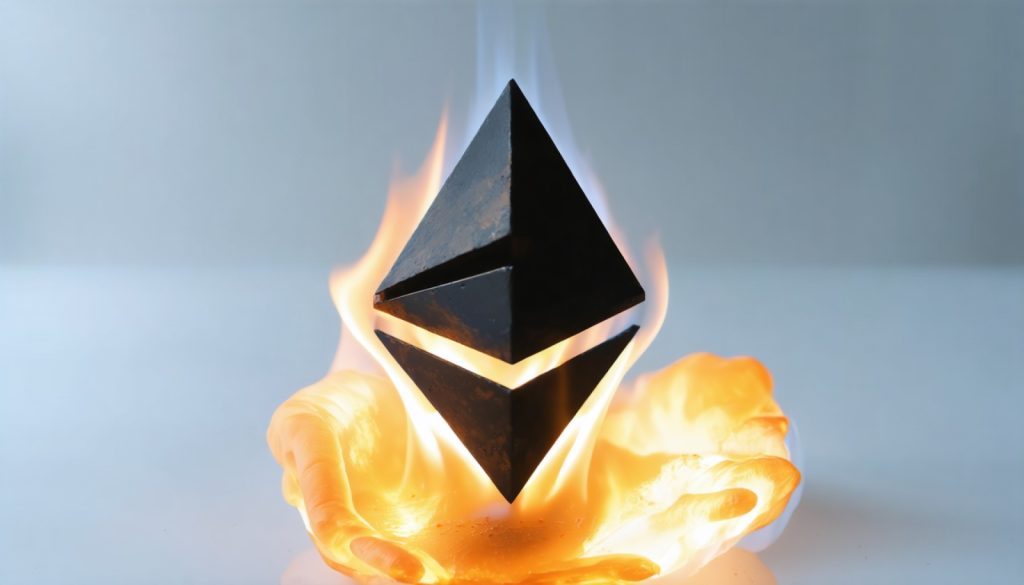
- Ethereum’s gas fees recently dropped to $0.01 but quickly rose to $0.26, highlighting ongoing volatility.
- Daily transaction volumes have remained stagnant at 1.1 million over the past three years, signaling limited growth.
- Layer-2 solutions and decentralized finance have yet to enhance Ethereum’s transaction efficiency significantly.
- Rivals like Solana are gaining ground with cheaper and faster transaction capabilities.
- Lower gas fees alone do not guarantee Ethereum’s success; sustained performance is crucial for future growth.
- Investors should remain cautious as Ethereum faces competitive pressure and questions about its potential.
Ether streams through the veins of the digital world, promising decentralized utopias and profitable ventures. Yet, beneath the crypto cosmos’ shimmering surface, Ethereum wrestles with a chronic ailment that haunts its promise: the notorious gas fees.
Recently, a surprising twist suggested Ethereum was on the mend. Around April 20, savvy investors noted that transactions were suddenly as inexpensive as $0.01 – a fantasy for anyone tired of the Ethereum fortunes tied to sky-high transaction costs. However, this glistening reprieve was soon shadowed by an uptick, propelling fees back to about $0.26. While still meager compared to the financial pain of $50 per transaction in the past, this volatility raises a crucial question: Is Ethereum truly progressing, or is this a misleading mirage?
Sliding from the microscopic to the macroscopic, Ethereum’s lifeblood hasn’t boiled with the refreshing vigor expected of a triumphant tech innovation. Instead, transactions seem more akin to echoes of the past than the futuristic crescendo promised by blockchain visionaries. Over the past three years, the number of daily transactions—standing stagnant at 1.1 million—unveils a sobering truth: the network isn’t overwhelmed with newfound success but is simply less jam-packed.
Enter the world of Layer-2 solutions, decentralized finance, and enormous expectations. Despite these extraordinary pursuits, the Ethereum transaction treadmill appears merely to maintain its pace rather than gain momentum. A severe warning bell for investors banking on an Ethereum-led digital renaissance.
To the careful observer, the narrative of Ethereum’s recovery demands skepticism. An evolving landscape populated by daring competitors like Solana, Ethereum’s rival, offers cheaper and swifter transactions, steadily encroaching on Ethereum’s territory.
The heart of the matter lies in Ethereum’s stagnant transaction volumes, subtly rebuking the narrative of increased adoption. If the network were indeed the cradle of blockchain proliferation, its ledgers should brim over with activity. Yet, they remain in frustrating equilibrium.
Though lower gas prices might sweeten the deal, they do not alone herald prosperity. Their staying power in the face of increased usage could point to future bullishness, but only time and consistent performance will tell that story. Until then, Ethereum investors must question: does the emperor of crypto wear new clothes, or is the sheen simply yesterday’s polish?
In a rapidly shifting digital world, Ethereum finds itself at a crossroads. The spectral fog of its past whispers caution: until Ethereum rises to its potential and stands steadfast against the energy of its contenders, investment might be best held beneath caution’s wing.
Will Ethereum’s Gas Fee Roller Coaster Impact Its Future?
Understanding Ethereum’s Gas Fees: Challenges and Opportunities
Ethereum is a foundational pillar of the cryptocurrency world, thriving on promises of decentralization and innovation. However, it constantly grapples with a persistent challenge: fluctuating gas fees. These fees are payments required to conduct transactions or execute contracts on the Ethereum network. Their volatility has been a significant hurdle for users and developers alike.
Key Insights Into Ethereum’s Gas Problem
1. Volatility in Gas Fees: As noted around April 20, transaction fees dropped to an astonishing $0.01 before climbing back to $0.26. This fluctuation, while lower than historical highs (up to $50 per transaction), highlights the network’s ongoing struggle with gas fees.
2. Stagnant Transaction Volumes: Despite technological advancements, Ethereum’s daily transaction volume remains static at approximately 1.1 million transactions. This stagnation indicates that Ethereum is not experiencing the explosive growth expected from a platform poised to lead a digital renaissance.
3. Layer-2 Solutions: These technologies aim to enhance Ethereum’s scalability by processing transactions off the main Ethereum chain. Technologies like Arbitrum and Optimism offer faster transactions at lower costs, slowly addressing the gas fee issue.
4. Competing Networks: Competitors such as Solana, renowned for their lower transaction costs and higher speed, challenge Ethereum’s dominance.
How-To: Optimize Ethereum Transactions
1. Monitor Gas Fees: Use resources like Ethereum Gas Tracker tools to execute transactions during periods of lower fees.
2. Utilize Layer-2 Solutions: Engage with protocols like Polygon or Loopring for cost-effective transactions, helping avoid the burdens of costly gas fees.
3. Set Transaction Priority: When using Ethereum, set your transactions with ‘average’ priority to avoid overpaying during high fee periods while still having a timely process.
Market Forecast and Industry Trends
– Ethereum 2.0 and Beyond: Ethereum is transitioning to Ethereum 2.0, featuring a Proof of Stake (PoS) consensus aimed at reducing energy consumption and network fees. The completion of this shift could fundamentally change gas fee dynamics.
– Decentralized Finance (DeFi) Growth: As DeFi continues to expand, it will strain or transform Ethereum’s infrastructure. Innovations within this space can offer opportunities to mitigate gas fee issues.
Reviews and Comparisons: Ethereum vs. Competitors
– Ethereum vs. Solana: While Solana offers quicker and cheaper transactions, Ethereum remains the preferred choice for developers due to its established ecosystem and robust security.
Pros and Cons Overview
Pros of Lower Gas Fees:
– Reduces barriers to entry for new users and developers.
– Stimulates participation in decentralized applications.
Cons of Gas Fee Volatility:
– Causes unpredictability and financial risk for users engaging with the network.
– Drives users to competitor platforms like Solana for more consistent transaction costs.
Actionable Recommendations
– Diversify Investments: Investors should consider a diverse portfolio that includes exposure to competing blockchain technologies to hedge against Ethereum’s current limitations.
– Stay Informed: Follow updates on Ethereum 2.0 and Layer-2 solutions to understand potential impacts on gas fees.
For more on Ethereum and cryptocurrency insights, visit Ethereum.
In conclusion, while Ethereum’s potential remains significant, safeguarding digital assets in a rapidly evolving landscape requires awareness and a strategic approach to the ecosystem’s inherent challenges.



